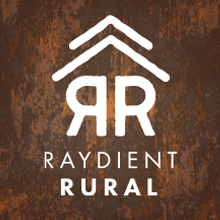How to Transform Raw Land into a Homestead

Thinking of buying raw land to transform into a homestead, but unsure how to start? This article covers all the basics, including land clearing, selecting a homesite, outside-the-box home design tips, plus a link to a comprehensive eGuide.
Buying a piece of raw land to turn into a homestead is one of the smartest investments you can make.
Land has been proven to hold its value and will increase in value as you transform it into the property of your dreams.
Whether you’re at the dreaming stage, shopping stage, buying stage or even if you already own land, this article and eGuide (linked at the end) will provide step-by-step instructions on how to take your land from wild and raw to a functional and beautiful country homestead.
Let's get started transforming your land into a homestead.
Step 1: Select a Homesite
You will save yourself a lot of time, disappointment and headaches if you learn how to identify a good homesite before you begin viewing (and falling in love with) properties.
Tips for Selecting the Perfect Homesite
- Work with an experienced team. That could include your broker (with whom you’ve worked to find the land and make an offer) as well as a builder or contractor with extensive experience building on rural land.
- Walk the entire property before selecting a homesite. Don’t just choose the easiest place to build or even necessarily the place with the best view (as views can change!). Keep an open mind, bring your builder along and explore a few opinions.
- Do a perc test. This basically tests whether or not your land is septic-system-compatible. If the land won’t perc, you can’t build on it.
- Do a soil test. Not all soil is compatible with all foundation types.
- Assess any issues with access. A beautiful homesite is no good if you can't access it. Consider things like easements and obstructions that could affect access to your home.
- Think about your driveway. The cost and complexity of installing a driveway can vary greatly and must be thoughtfully considered.
- Get familiar with zoning and other ordinances. This may impact where and what you can build.
- Be wise about utilities. Contact your local power company to inquire how much they charge per square foot, keeping in mind the further from the road, the greater the cost.
- Think about land clearing. We’ll have much more on land clearing in the next section, but you’ll want to factor in the cost of any land clearing into your budget when choosing a homesite.
For more details from our experts, check out:
- Where to Build Your House on Your Land
- Due Diligence: How to Make Sure Your Land is Buildable
- Why and How to Install a Driveway on Your Rural Land
Step 2: Clear Land for a Homesite
Land clearing can be intimidating, especially if you're amidst a forest and new to all this.
Careful planning, budgeting and hiring the right team is essential.
Here's what this looks like:
Step 1: Decide how many trees to clear
This will all depend on your needs, but clear as few trees as possible to meet your property requirements.
You’ll also want to know about any county tree ordinances that may place limitations on how much you can remove.
How much space should you leave between your home and your trees?
The Florida Department of Agriculture and Consumer Services recommends establishing at least 30 feet of “defensible space” around your home. Within that 30-foot range, aim for
- 10 to 15 feet of space between the individual crowns (tops) of trees.
- Tree limbs pruned to a minimum of 6 feet from the ground.
- More individual plantings, less clustered plantings.
Step 2: Find a Land Clearing Service
This is generally not the type of project you want to DIY.
If you have a General Contractor they may be able to do this for you or subcontract the work. Regardless, get several quotes as prices can vary greatly.
Step 3: Pull Permits If Applicable
Not all counties require a permit, but check with the land clearing company and local authorities.
Step 4: Get A Survey
A boundary survey is an excellent way to ensure you're clearing only on your property and not your neighbor's.
Get more tips in:
Step 5: Mark the space you want cleared
Clearly mark the space you want cleared using flagging tape, and walk that area with your contractor.
As an added level of insurance, use Google Earth to mark off and calculate the area, then provide a copy of this to your surveyors and contractors.
Finally, be there on the day of clearing to walk the area one final time with your contractors and ensure accuracy.
Our eGuide: How To Transform Land Into A Homestead shares additional tips on land clearing, including how to clear land for a farm, what to do with trees and stumps and tips for the determined DIYer.
Step 3: Find The Right Contractor To Build Your Home & Outbuildings
We've all heard the horror stories of home builds gone wrong or exponentially over budget by less-than-reputable contractors.
Here are some tips to help you find the right contractor for you land.
- Start with word of mouth: Ask trusted friends, colleagues and experts---like your realtor, land agent, local planning and development office or local building department---for referrals.
- Get more than one bid on the project. It pays to shop around to get a feel for pricing.
- Make sure your potential contractor is properly licensed. Contact your State’s Department of Business and Professional Regulations; and your local county building department to inquire about licensing requirements.
- Find out who will do the work. General contractors typically don't do all the work, so find out who they subcontract with and make sure they are also properly licensed and vetted.
- Get references — and actually call them. Don't just rely on online reviews or glowing reviews from friends. Get as many references as you can and call them.
Get more tips on questions to ask references in How To Transform Land Into A Homestead.
Step 4: Choose the Right House
Some people already have their dream home picked out before they set foot on potential properties. If that's you, you can skip this section.
For everyone else, here are some helpful tips:.
- Make sure the home you want to build suits the land you want to buy.
This goes back to the first step on choosing the proper home site as not every home style will suit your land.
- Unless you’re a cash buyer, apply for your construction loan as early as possible.
Building cannot begin until your construction loan is approved, so, unless you already got the loan through a land/home package, get the application process started as soon as possible.
Get more tips in: How Construction Loans Work
- Obtain new construction permit approvals for the project before you build.
Several permits are typically required before building can begin such as septic, well and other building permits.
- Take dirt and drainage seriously
A lot of dirt has to be removed before construction can begin. You'll want to consider drainage carefully, as the higher your home the less likely you'll have drainage issues.
- Begin building with county codes and inspections in mind at all stages.
The average home requires about 10 or more inspections during the building process (some require more, some require less), which are completed by your county’s Building Department. This helps to ensure that everything — the plumbing, foundation, the nailing, the framing and septic system — are installed in a manner that is safe for you and your neighbors.
The How To Transform Land Into A Homestead eGuide provides much more details and advice on the home building selection and process, including:
- The benefits of modular homes
- Exploring outside-the-box homes like earth-sheltered homes, cob homes, and more
- What's involved in well and septic installation
Step 5: Land design/landscaping
One of the best things about building from raw land is you have a blank slate to create the land design of your dreams.
This may include:
- Installing a pond or water features
- Setting up gardens for self-sufficiency and/or a business such as a market garden, CSA, herb farm or flower farm
- General landscaping with ornamentals
- Adding permaculture elements such as swales, windbreaks, orchards and other functional landscaping elements
Download The How To Transform Land Into A Homestead for much more details on elements of land design and lanscaping and check out the following articles:
- How To Build A Pond Or Lake On Your Property
- 9 Steps Towards Self-Sufficient Landscaping
- How a Soil Scientist Creates a Low-Maintenance Garden in the South
- Tips for Starting a Flower Farm Business
Step 6: Plan For Outbuildings
For most landowners, the construction of their dream home is just the beginning of many, many building projects, including:
- Barns and sheds
- Chicken coops
- Office Pods
- Greenhouses and High tunnels
- Garages
- And more
Click the links above for more information or download The How To Transform Land Into A Homestead for expert advice on constructing barns, chicken coops and more.
There You Have It! The Basics For Transforming Land Into A Homestead
We hope this article has given you an idea of what's possible when you start with raw land to build your homestead, recreational property or country dream home.
Are there more details involved? Oh yes, many. The The How To Transform Land Into A Homestead eGuide covers all that, so you can plan like a pro.
A homestead built from scratch is a legacy like none other, one that can be cherished and enjoyed for generations to come.
















Your email address will not be published. Required fields are marked*